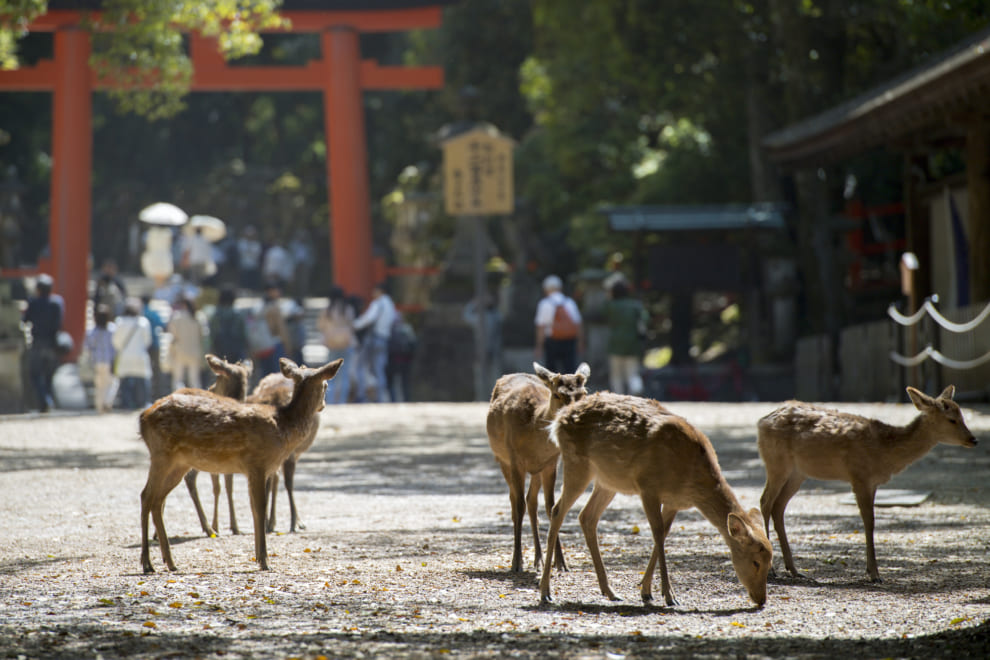
Kasuga Taisha Shrine and deer, Nara Prefecture
When thinking of deer in Japan, the immensely popular deer in Nara Park immediately come to mind. Garnering a cult-like following, many people visit the park just to come into contact with these fascinating animals. One implication of this may be that in the minds of the Japanese today, deer have become a bit detached from their lives.
However, deer appear a great deal in the myths of Japan, playing a variety of roles and taking on a number of unique personalities. In particular, a number of uniquely individual deer appear in Fudoki, local records that detail local legends and the origin of place-names. These include a tale of a deer captured by some villagers for repeatedly ravaging their farm fields that begs for mercy when its head is on the chopping block. Another tale relates a deer that views a dream in which it is killed and then foolishly sees its fate come to fruition. In some parts of the country people still seek deer for food and consider them to be pests these days, but in ancient times, they most likely played a bigger role in people’s lives than they do today.
Meanwhile, Ame-no-Kaku, a deer deity which appears in the Kojiki, is depicted as a truly trustworthy divine being.
Once upon a time in Takamanohara, or the “Plain of High Heaven,” Amaterasu believes her offspring should rule Ashihara-no-Nakatsukuni, the earthly realm currently governed by deity Ōkuninushi. Therefore, Amaterasu dispatches an emissary to Ōkuninushi, beseeching him to yield the realm, but not only the first, but also a second emissary sent by Amaterasu fails to convince Ōkuninushi, with both of them switching sides and swearing allegiance to the earthly deity. Then, the names of deity Itsu-no-Ohabari and his son Takemikazuchi come up when Amaterasu considers who to send as the third emissary. However, the two deities live a secluded life in the steep, mountainous area of the headwaters of a river, making it all but impossible for the other heavenly deities to make the trek to seek their help in person. To achieve this task, Amaterasu chooses Ame-no-Kaku, likely because being a deer, Ame-no-Kaku has the ability to surmount the rugged terrain. In the end, Takemikazuchi agrees to be the third emissary and through his negotiations with Ōkuninushi, the descendants of Amaterasu soon come to rule Ashihara-no-Nakatsukuni.
Thanks to this myth, among others, ancient people viewed deer as a Shinshi, or “divine servants,” of Takemikazuchi. Takemikazuchi is first enshrined at Kashima Jingu shrine in Ibaraki Prefecture, but later, he is summoned to the capital city of Nara around the time of the founding of Kasuga Taisha shrine, which is built to pray for the stability of the country. It is said that Takemikazuchi makes this journey by riding on a white deer all the way from Kashima. This is why people continue to treat the deer of Nara Park as divine servants today.
Deer have magnificent antlers that grow over the course of a year and then molt in spring. Thus, many people view the deer as an animal that symbolizes death and rebirth.
Deer also appear in myths all over the world. In Greek mythology, for example, Artemis is a goddess who traverses fields and mountains to hunt. Her symbol is the Ceryneian Hind, a doe which has golden antlers and can run faster than an arrow in flight. The Celtic deity Cernunnos, meanwhile, is the lord of beasts and deer antlers grow on his head. In the animated film “Princess Mononoke,” the mountain deity “Shishigami” presides over death and rebirth and has deer antlers. Ame-no-Kaku, the divine servant chosen by Amaterasu, may have also been a magnificent deity that ruled the natural world of the Plain of High Heaven in which Takemikazuchi lived.
Kikuko HIRAFUJI
Research
Mythology, Religious Study, History of Religion
Papers
Deities in the interwar period(2023/09/08)
Translation Issues in Kojiki: God, Deity, or Spirit?(2016/01/01)

